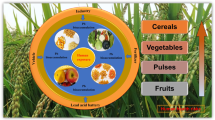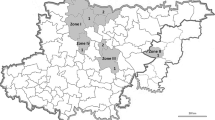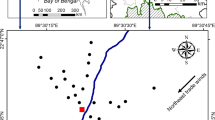Abstract
Lead, zinc and cadmium were analysed in a range of subsistence crops cultivated in and around Nairobi city centre. Lead was found to be the only contaminant of concern, being widely dispersed with elevated levels found in crops and soils from both suburban and city centre areas. Extremely high concentrations were recorded in the edible portions of a variety of crops, and high soil Pb levels were recorded within 30m of busy roads. Based on these data, it is estimated that subsistence on a diet of crops cultivated in and around Nairobi could increase Pb intake by 10–100 times the FAO/WHO maximum tolerable levels, potentially contributing substantially to existing health problems.
Similar content being viewed by others
References
Anon, 1973.The analysis of agricultural materials. ADAS Bulletin 27, Ministry of Agriculture, Fisheries and Food, U.K.
Barrass, R. 1976.Biology, food and people. Hodder and Stoughton, London.
Bennett, B.G. 1981.Exposure commitment assessment of environmental pollution. Vol.1. MARC Report No.23, MARC/UNEP.
Berrow, M.L. and Reaves, G.A. 1984. Background levels of trace elements in soils.Environmental Contamination (International Conference — London, July 1984), CEP, Edinburgh, 333–340.
Demayo, A., Taylor, M.C., Taylor, K.W. and Hodson, P.V. 1982. Toxic effects of lead and lead compounds on human health, aquatic life, wildlife plants and livestock.Critical Reviews of Environmental Control 12, 257–305.
Dickinson, N.M., Lepp, N.W. and Ormand, K.L. 1984. Copper contamination of a 68 year old coffee (Coffea arabica L.) plantation.Environmental Pollution (Series B),7, 223–231.
Dickinson, N.M. and Lepp, N.W. 1985. A model of retention and loss of fungicide-derived copper in different-aged stands of coffee in Kenya.Agriculture, Ecosystems and Environment 14, 15–23.
Esmat, A.A., Nasralla, M.M. and Shakour, A.A. 1986. Spatial and seasonal variation of lead in Cairo atmosphere.Environmental Pollution (Series B) 11, 205–210.
FAO/WHO. 1978. Report of the joint FAO/WHO expert committee on food additives.Technical Report Series of the World Health Organisation No.631.
Harris, M.R., Harrison, S.J. and Lepp, N.W. 1984. Seasonal variation in the metal content of amenity grass, and its use as an indicator of reclamation treatment performance.Science of the Total Environment 34, 267–278.
Harrison, R.M. and Laxen, D.P.H. 1981.Lead pollution: causes and control. Chapman and Hall, London.
Hibben, C.R., Hagar, S.S. and Mazza, C.P. 1984. Comparison of cadmium and lead content of vegetable crops grown in urban and suburban gardens.Environmental Pollution (Series B) 7, 71–80.
Ireland, F.E. 1981.Reduction of lead in the environment — energy,technology and cost. Report of a Working Party on Lead, Fellowship of Engineering, London.
Koeppe, D.E. 1981. Lead: understanding the minimal toxicity of lead in plants.In: N.W. Lepp (Ed.)Effects of heavy metal pollution on plants. Vol.1. Applied Science Publishers, London.
Lau, W.M. and Wong, M.H. 1983. The effect of particle size and differential extractants on the content of heavy metals in roadside dust.Environmental Research 31, 229–242.
Little, P. and Wiffen, R.D. 1977. Emission and deposition of petrol engine exhaust lead. 1. Deposition of exhaust lead to plant and soil surface.Environmental Pollution 18, 265–274.
Manicol, R.D. and Beckett, P.H.T. 1985. Critical tissue concentrations of potentially toxic elements.Plant and Soil 85, 107–129.
Mombeshora, C., Osibanjo, O. and Ajayi, S.O. 1983. Pollution studies on Nigerian rivers: the onset of lead pollution of surface waters in Ibadan.Environment International 9, 81–84.
Nasralla, M.M. 1984. Lead in Jeddah urban dust.Environmental Pollution (Series B) 8, 133–141.
Ndiokwere, C.L. 1984. A study of heavy metal pollution from motor vehicle emissions and its effect on roadside soil, vegetation and crops in Nigeria.Environmental Pollution (Series B) 7, 35–42.
OCTEL, 1986.World wide survey of motor gasoline quality. Sales publication No. 4 (May, 1986). Associated Octel Company Ltd., London.
Odenbro, A., Greenberg, N., Vroegh, K., Bederka, J. and Kihistom, J-E. 1983. Fundamental disturbances in lead-exposed children.Ambio 12, 40–43.
O'Neill, P. 1985.Environmental Chemistry, George Allen and Unwin, London.
Osore, H. 1983. Pollution and public health in East Africa.Ambio 12, 316–321.
Rabinowitz, M. and Wetherill, G.W. 1972. Identifying sources of lead-contamination by stable isotope techniques.Environment, Science and Technology 6, 705–709.
Reynold, J.E.F. (Ed.) 1982.Martindale: the extra pharmocopeia. 28th edition. The Pharmaceutical Press, London.
Rodriguez-Flores, M. and Rodriguez-Castellon, E., 1982. Lead and cadmium levels in soil and plants near highways and their correlation with traffic density.Environmental Pollution (Series B) 5, 281–290.
Were, P.T. A. 1983. The development of road transport in Africa and its effects on land use and environment.Industry and Environment (UNEP) 6, 25–26.
Wheeler, G.L. and Rolfe, G.L. 1979. The relationship between daily traffic volume and the distribution of lead in roadside soils and vegetation.Environmental Pollution 18, 265–274.
Williams, E.V. 1978. New techniques for the digestion of biological materials — application to the determination of tin, iron and lead in canned food.Journal of Food Technology 13, 367–384.
WHO (1977)Environmental Health Criteria 3: Lead UNEP/WHO, Geneva.
WHO/UNEP (1985).Assessment of human exposure to lead: comparison between Belgium, Malta, Mexico and Sweden. Karolinska Institute, Stockholm and Ministry of Health, Brussels.
Author information
Authors and Affiliations
Rights and permissions
About this article
Cite this article
Dickinson, N.M., Lepp, N.W. & Surtan, G.T.K. Lead and potential health risks from subsistence food crops in urban Kenya. Environ Geochem Health 9, 37–42 (1987). https://doi.org/10.1007/BF01686173
Received:
Accepted:
Issue Date:
DOI: https://doi.org/10.1007/BF01686173




